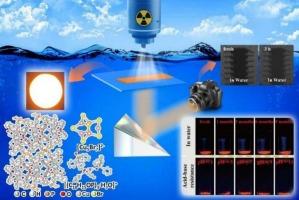Ultra-stable hybrid copper(I) halides with a “molecular armor” of three-dimensional hydrogen bond network for extreme environment applications
IF 9.7
1区 化学
Q1 CHEMISTRY, PHYSICAL
引用次数: 0
Abstract
Developing materials with high optoelectronic performance under extreme conditions, including high temperature, high pressure, and exposure to chemical corrosion, is crucial for applications in harsh environments. In this study, [(C18H15OP)3·H3O]2Cu5Br7 (CHCB), a non-toxic hybrid halide scintillator with outstanding stability and performance under challenging conditions, was developed. CHCB achieved high photoluminescence quantum yields of 97.75 % and retained excellent optical properties even after prolonged water immersion, wide pH exposure, and high-pressure treatment, highlighting its potential for underwater imaging and radiation detection. Flexible scintillator films made from CHCB exhibited high-resolution imaging capabilities (9.21 lp·mm−1) and a light yield of 19,088.9 ph·MeV−1, even after prolonged underwater exposure. Additionally, the dynamic information encryption potential of the CHCB crystals, demonstrated through an ultraviolet-triggered binary encoding system, underscored their multifunctionality. These findings position CHCB as a promising candidate for sustainable, high-performance scintillators in extreme environments and advanced optoelectronic applications.

具有三维氢键网络“分子盔甲”的超稳定杂化铜(I)卤化物,适用于极端环境。
在极端条件下开发具有高光电性能的材料,包括高温,高压和暴露于化学腐蚀,对于恶劣环境中的应用至关重要。在这项研究中,[(C18H15OP)3·h30]2Cu5Br7 (CHCB)是一种无毒的杂化卤化物闪烁体,在挑战性条件下具有出色的稳定性和性能。CHCB的光致发光量子产率高达97.75%,即使经过长时间的水浸泡、宽pH暴露和高压处理,也能保持优异的光学性能,突出了其在水下成像和辐射检测方面的潜力。由CHCB制成的柔性闪烁体薄膜即使在长时间水下曝光后也具有高分辨率成像能力(9.21 lp·mm-1)和19,088.9 ph·MeV-1的光产率。此外,通过紫外触发二进制编码系统证明了CHCB晶体的动态信息加密潜力,强调了它们的多功能性。这些发现使CHCB成为极端环境和先进光电应用中可持续的高性能闪烁体的有希望的候选者。
本文章由计算机程序翻译,如有差异,请以英文原文为准。
求助全文
约1分钟内获得全文
求助全文
来源期刊
CiteScore
16.10
自引率
7.10%
发文量
2568
审稿时长
2 months
期刊介绍:
The Journal of Colloid and Interface Science publishes original research findings on the fundamental principles of colloid and interface science, as well as innovative applications in various fields. The criteria for publication include impact, quality, novelty, and originality.
Emphasis:
The journal emphasizes fundamental scientific innovation within the following categories:
A.Colloidal Materials and Nanomaterials
B.Soft Colloidal and Self-Assembly Systems
C.Adsorption, Catalysis, and Electrochemistry
D.Interfacial Processes, Capillarity, and Wetting
E.Biomaterials and Nanomedicine
F.Energy Conversion and Storage, and Environmental Technologies

 求助内容:
求助内容: 应助结果提醒方式:
应助结果提醒方式:


